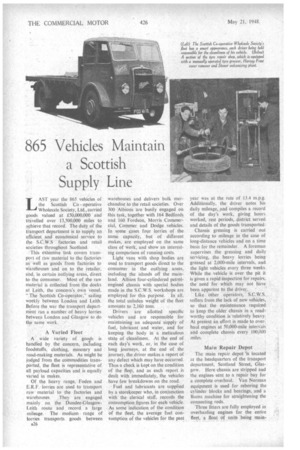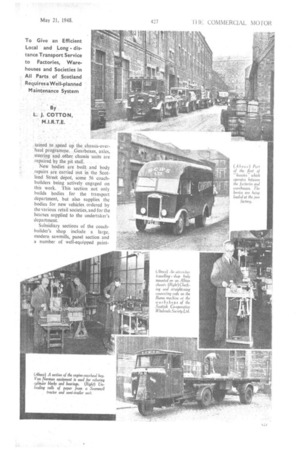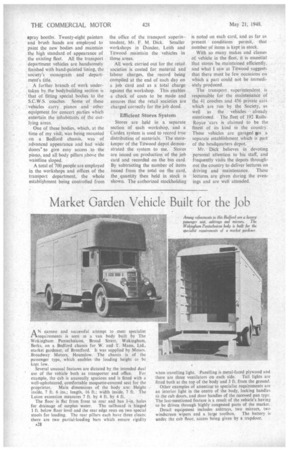865 Vehicles Maintain a Scottish Supply Line
Page 28

Page 29

Page 30

If you've noticed an error in this article please click here to report it so we can fix it.
L. AST year the 865 vehicles of the Scottish Co operative . Wholesale Society, Ltd., carried goods valued at £50,000,000 and travelled over 13,500,000 miles to achieve that record. The duty of the transport department is to supply an efficient and econcimical .service to the s.e.w.s factories and retail societies throughout Scotland;
This extensive task covers transport of raw material to the factories aS•Well as goods from factories to Warehouses and on to the retailer. arid, in certain outlying areas, direct to the consumer. Most of the raw material is collected from the docks at Leith, the concern's own Vessel, "The Scottish Co-operator," sailing weekly between London and Leith. Before the war the transport departdent ran a number of heavy lorries between London and Glasgow to do the' same A Varied Fleet A wide variety of goods is handled by the concern, incTuding foodstuffs, clothing, masonry and road-making materials. As might be judged from the commodities transported, the fleet is representative of all payload capacities and is equally varied in makes.
Of the heavy range, Foden and E.R.F.• lorries are used to transport raw • material to the factories and warehouses. They are engaged mainly on the Dundee-GlasgowLeith route and record a large .mileage. The medium . range of lorries transports goods between warehouses and delivers bulk merchandise to the retail societies. Over 300 -Albions are busily engaged on this task, together with 164 Bedfords and 160 Fordson, Morris Commercial, Commer. and Dodge vehicles. In some cases four lorries of the. same capacity, but of different makes, are employed on the same class of work, and show an interesting comparison of running costs.
Light vans with shop bodies are used to transport goods direct to the consumer in the outlying areas, including the islands off the mainland. Albion four-cylindered. petit+ engined chassis with special bodies made in the S.C.W.S. workshops are employed for this purpose. In all, the total unladen weight of the fleet
amounts to 2,160 tons.
Drivers are allotted specific vehicles and are responsible for maintaining an adequate supplyof fuel, lubricant and water, and for keeping the body in a meticulous state of cleanliness. At the end of each day's work, or, in the case of long journeys, at the end of the journey, the driver makes .a report of any defect which may have occurred. Thus a check is kept on the condition of the fleet, and as each report is dealt with immediately, the vehicles have few breakdowns on the road.
Fuel and lubricants are supplied by a storekeeper who, in conjunction with the clerical staff, records the consumption figures for each vehicle. As some indication of the condition of the fleet, the average fuel consumption of the vehicles for the past year was at the rate of 13.4 m.p.g. Additionally, the driver notes his daily mileage, and compiles a record of the day's work, giving hours, worked, rest periods, district served and details of the goods transported.
Chassis greasing is carried out according to mileage in the case of long-distance vehicles and on a time basis for the remainder. A foreman supervises the greasing and daily • servicing, the heavy lorries being greased at 2,000-mile intervals, and
the light vehicles every three weeks. While the vehicle, is over the pit it is-given a rapid ihspeetiori for' repairs, the need for• which may not have been apparent to the driver.
Like. Other operators,S.C.W.S.. suffers from the lack of new vehicles, so that the maintenance requiredto leep the older chassis in a roadworthy condition is relatively heavy.. At present an effort is made to over-.. haul engines at 50,006-mile intervals and complete chassis every 100,000
miles. .
Main Repair Depot The main repair depot Is located at the headquarters of the transport department, Scotland Street, Glasgow. Here chassis are stripped and the engines sent to a repair bay for a complete overhaul. Van Norman equipment is used for reboring the cylinder blocks and bearings, and a Burna machine for straightening theconnecting rods.
Three fitters are fully employed in overhauling engines for the entire fleet, a float of units being main
. tamped to .speed up the chassis-over', haul programme. :Gearboxes, axles, steering arid .other chassis units are
repaired by the pit staff. .
Nei bodies are built and body repairs are 'carried out in the Scotland Street depot, some 56 coachbuilders being actively engaged on this work. This section not only builds bodies for the transport department, but also supplies the bodies for new vehicles ordered by the various retail societies, and for the hearses supplied to the undertaker's department.
Subsidiary sections of the coachbuilder's shop include a large. modern sawmills, panel section and a number of well-equipped paint spray booths. Twenty-eight painters and brush hands are employed to paint the new bodies and maintain the high standard of appearance of the existing fleet. All the transport department vehicles are handsomely . finished with hand-painted lining, the society's monogram and department's title.
A further branch of work undertaken by the bodybuilding section is that of fitting special bodies to the S.C.W.S. coaches. Some of these vehicles carry. pianos and other equipment for concert parties which entertain the inhabitants of the outlying areas.
• One of these bodies, which, at the time of my visit, was being mounted on a Bedford chassis. was of advanced appearance and had wide doors' to give easy access to the piano, and all body pillars above the waistline sloped.
A total of 700 people are employed in the workshops and offices of the transport department, the whole establishment being controlled from the. office of the transportsuperintendent, Mr. F. M. Dick. Smaller workshops in Dundee, Leith and Titwood maintain the vehicles in those areas.
All work carried out for the retail societies is costed for material and labour charges, the record being compiled at the end of each day on a job card and as a total charge against the workshop. This enables a cheek of costs to be made and ensures that the retail societies are charged correctly for the job dons.
Efficient Stores System Stores are held in a separate section of each workshop, and a Cardex system is used to record true distribution of materials. The storekeeper of the Titwood depot demonstrated the system to me. Stores are issued on production of the job card and recorded on the bin card. By subtracting the number of items issued from the total on the card, the quantity then held in stock is shown. The authorized stockholding is noted on each card, and as far as present • conditions permit,that number of items is kept in stock.
With so many makes and classes of vehicle in the fleet, it is essential that stores be maintained efficiently, and what I saw at Titwood suggests that there must be few occasions' on which a part could net be immediately produced., The transport, superintendent. is responsible for the maintenance of the 41. coaches and 4% private cars which are run by the Society, as • well as the vehicles already mentioned. The fleet of 192 RollsRoyce *cars is claimed to be the finest of its kind in the country. These vehicles are garaged sin a separate establishment which is part'
of the headquarters depot.
Mr. Dick believes in devoting personal attention to his staff, and frequently visits the depots throughout the country to deliver lectures on driving and maintenance. These lectures are given during the evenings and are well attended.












































































